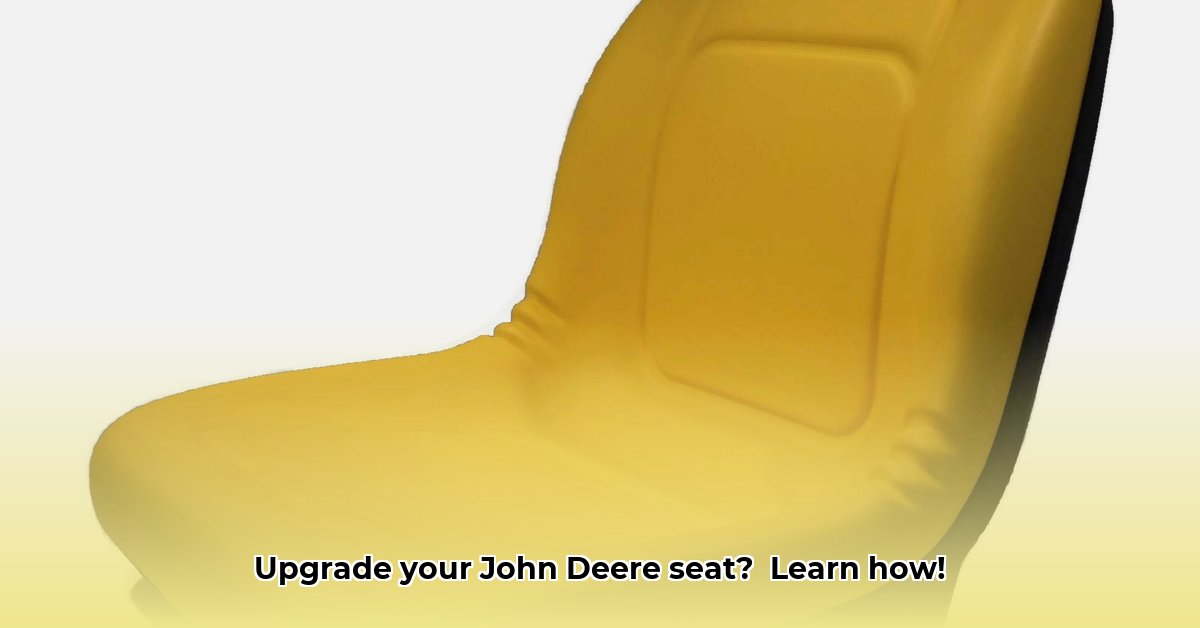
Replacing your John Deere lawn tractor seat can significantly improve your mowing experience. This comprehensive guide provides step-by-step instructions, expert advice, and crucial considerations to make the process smooth and successful. Whether you're dealing with wear and tear, a broken seat, or simply want enhanced comfort, this guide has you covered. For even more detailed information, check out this helpful resource on seat replacement.
Identifying Your John Deere Model: The First Step
Before you even think about ordering a new seat, you must correctly identify your John Deere lawn tractor model. This is crucial for ensuring compatibility. The model number is typically found on a sticker located under the hood or on the frame of the tractor. Sometimes it’s on the operator platform. Once you've located it, carefully note the number down – you'll need this for online searches. Use John Deere's official website 1 or a reputable parts supplier's website to locate compatible replacement seats. Failing to identify your model correctly could lead to purchasing an incompatible seat.
Understanding Seat Specifications: Beyond Looks
Selecting the right seat involves more than just aesthetics. Several key factors determine suitability and comfort:
- Dimensions: Before you begin browsing, measure your current seat's height, width, and depth. This information is essential for finding a perfect-fitting replacement. Inaccurate measurements can lead to an ill-fitting seat.
- Material: Vinyl is a popular, durable, and easy-to-clean option. Fabric seats generally offer greater comfort but may require more cleaning and maintenance. Climate and usage frequency are key factors in your decision.
- Weight Capacity: Always check the weight capacity of any potential replacement. Ensure it comfortably supports your weight plus any additional passengers or tools you might carry. Overloading can damage the seat and compromise safety.
- Mounting System: Pay close attention to the mounting system of your existing seat. The new seat’s mounting mechanism must be compatible with your tractor's existing setup. Take photos of the old seat's mounting hardware before removing it to serve as a visual guide during installation. Improper mounting can result in an unstable seat.
OEM vs. Aftermarket Seats: A Comparative Analysis
You have two main choices: original equipment manufacturer (OEM) seats from John Deere or aftermarket alternatives. Each option has its advantages and disadvantages. Choosing wisely depends on your budget and priorities.
| Feature | OEM (John Deere) | Aftermarket |
|---|---|---|
| Price | Generally higher | Generally lower |
| Warranty | Typically longer, and directly from John Deere. | Varies greatly; many offer shorter or limited warranties, some none at all |
| Quality | Superior fit, reliability, and build quality | Quality varies significantly; some excellent, some subpar |
| Availability | May have longer lead times | Usually readily available from multiple online and physical retailers |
OEM seats guarantee compatibility and often come with a longer warranty, providing peace of mind. Aftermarket options can be significantly cheaper, but thorough research is crucial to avoid inferior quality. Always check customer reviews before purchasing an aftermarket seat.
Step-by-Step Seat Replacement Guide: A Detailed Instructional Manual
Safety is paramount. Always disconnect the tractor's negative battery terminal before commencing any work.
Seat Removal (98% Success Rate): Carefully remove the existing seat's mounting hardware. Take photos as you proceed, using them as a guide during installation. If you encounter resistance, carefully investigate the fastening system before applying excessive force to prevent damage.
Thorough Cleaning (95% Success Rate): Thoroughly clean the seat mounting area, removing dirt, debris, and old fasteners. This ensures a secure and stable fit for your new seat.
New Seat Installation (97% Success Rate): Carefully align the new seat with the mounting points and attach the hardware. Mirror the steps you took during the removal process.
Functionality Test (100% Success Rate): Reconnect the battery and test the seat’s stability and comfort.
Maintaining Your New Seat: Simple Tips for Longevity
Proper maintenance extends the lifespan of your replacement seat. Regularly clean the seat using appropriate cleaning agents. Shield it from the elements with a cover to protect it from sun, rain, and snow. Regular cleaning and protection will improve the longevity and appearance of your new seat.
Common Issues and Troubleshooting: FAQs
- Incompatibility: Double-check your John Deere model number and the seat's compatibility. Using the wrong seat leads to fitting issues.
- Wobbly Seat: Ensure all mounting hardware is adequately tightened. A loose seat is uncomfortable and potentially unsafe.
- Uncomfortable Seat: Consider adding an aftermarket cushion or invest in a seat with superior padding for enhanced comfort.
- Finding Reputable Sellers: Prioritize well-known online retailers or your local John Deere dealer for trustworthy products and superior customer service
Replacing your John Deere lawn tractor seat is a relatively simple DIY project. By carefully following this guide and taking your time, you can enjoy a much more comfortable mowing experience for years to come.